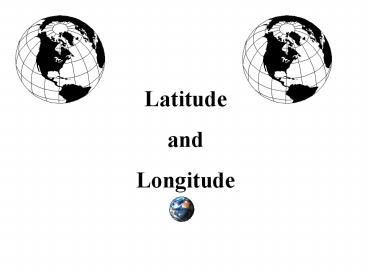Latitude PowerPoint PPT Presentation
1 / 19
Title: Latitude
1
Latitude and Longitude
2
- Scientists have established a coordinate system
using circular lines to pinpoint any place on the
Earth. - The first Coordinate system was used by
Hipparchus between 190 and 120 B.C. - This Coordinate System is based on lines of
- Latitude
- East/West parallel lines.
- Main reference line is the Equator.
- Longitude
- North/South lines from Pole to Pole
- Main Reference line is the Prime Meridian
3
- Latitude
- Known as Parallels.
- Equator - Line drawn around the Earth that is
equidistant to each pole. - Lines of Latitude are imaginary lines drawn
around the Earth parallel to the equator. - Equator 0 degrees
- North Pole 90 North Latitude
- South Pole 90 South Latitude
- In the Northern Hemisphere,
- Latitude the angular altitude of the
North Star (Polaris) Also known as the Pole
Star.
4
- Latitude Continued
- The half of the Earth NORTH of the Equator has
lines of North Latitude and is known as the
Northern Hemisphere. - The half of the Earth SOUTH of the Equator has
lines of South Latitude and is known as the
Southern Hemisphere.
5
Lines of Latitude
Tropic of Cancer 23.5 N.
Equator
Tropic of Capricorn 23.5 S.
6
90
Angle to Polaris
Latitude in the Northern hemisphere is determined
by the altitude of the North Star Polaris. Polari
s is in the constellation Ursus minor, also known
as, the little dipper
60
30
0
Its name comes from the Latin, Stella Polaris,
meaning "Pole Star."
7
The angle to Polaris is equal to the
Latitude For Example, if we measured the angle
to be 45 , then we would be located at 45
North Latitude.
Polaris
Angle to Polaris
Horizon
8
Finding Polaris and Ursa Minor To find the star
Polaris and the constellation Ursa Minor, locate
the two end stars in the cup of the "Big Dipper."
Connect a line through these two stars. This will
point to the star Polaris. Polaris is in the
constellation Ursa Minor. Ursa Minor is better
known as the "Little Dipper." Polaris will not be
an extremely bright star, about the same
brightness as the "pointer stars." Polaris is
also known as the North Star because it is
directly above the Earth's North Pole. This star
is about fifty (50) light years away from Earth.
9
The Big Dipper
10
- Longitude
- Lines of Longitude are known as Meridians.
- 0 degrees Longitude runs from Pole to Pole
through the town of Greenwich England. - This is the Prime Meridian.
- Maximum Longitude is 180 degrees and is opposite
Greenwich England on the Earth. - This is known as the International Date Line.
11
- Longitude continued
- The half of the Earth WEST of Greenwich, England
has lines of West Longitude and is known as the
Western hemisphere. - The half of the Earth EAST of Greenwich, England
has lines of East Longitude and is known as the
Eastern hemisphere.
12
- Longitude continued
- Find the difference in hours between local time
and Greenwich time. - Multiply the difference by 15 per hour (The rate
at which the Earth Rotates) - If Local time is earlier than Greenwich time,
then your position is West Longitude. - If Local time is later than Greenwich time, then
your position is East Longitude.
13
Noon
100pm
1100am
200pm
1000am
15
15
15
15
Prime Meridian
14
Examples There is a 5 hour time difference
between New York City and Greenwich, England.
What is the Longitude of NYC? (Local Time in
NYC is earlier than Greenwich)
15
ANSWER
75 West Longitude
16
Try This One
- It is 1000am at a point located 45 West
Longitude. It is 200 pm at your location. What
is your longitude?
17
Answer
- 15 East
18
One More
- It is 12 noon at the Prime Meridian. You are on
a boat where it is 400 am. You look up at the
sky and determine the altitude of Polaris to be
35. What is your Latitude and Longitude.
19
Answer
- 35 N 120 W

